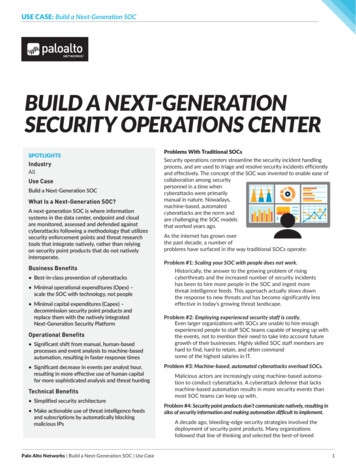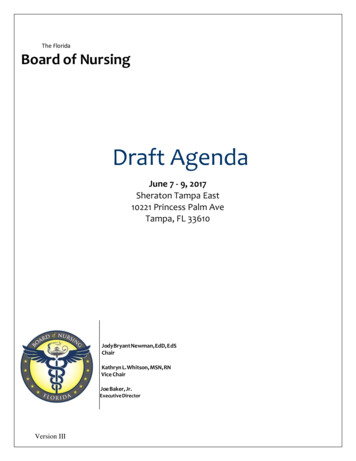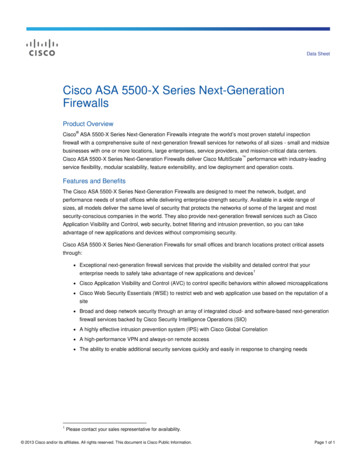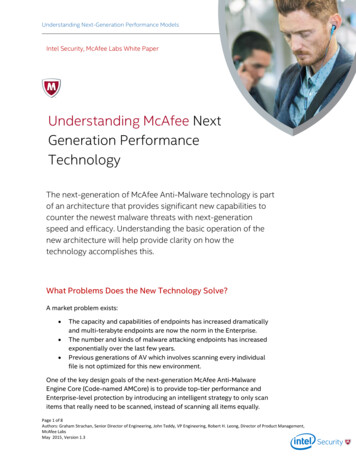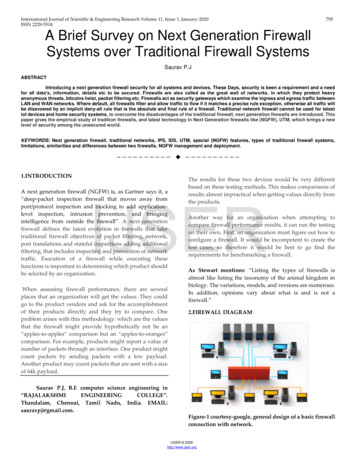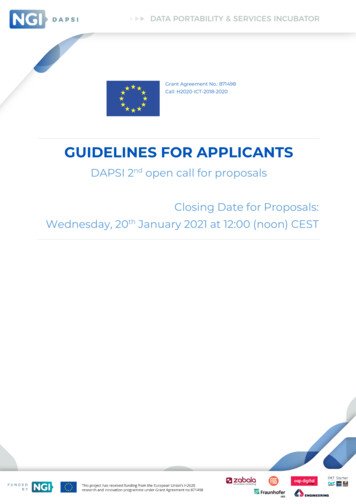
Transcription
Grant Agreement No.: 871498Call: H2020-ICT-2018-2020GUIDELINES FOR APPLICANTSDAPSI 2nd open call for proposalsClosing Date for Proposals:Wednesday, 20th January 2021 at 12:00 (noon) CEST
Table of Contents1OVERVIEW AND SUMMARY OF THE OPEN CALL . 41.1What types of projects will be eligible? . 51.2What happens after the proposals are submitted? . 102ELIGIBILITY CRITERIA . 112.1Types of beneficiaries. 112.2Project scope . 122.3ElIgible countries . 132.4Language . 132.5Multiple submissions . 132.6Submission system . 142.7Deadline . 152.8Absence of conflict of interest. 152.9Other . 153EVALUATION PROCESS . 163.1Evaluation proposals and access to DAPSI programme . 163.2Negotiation process . 184FINANCIAL SUPPORT PROVIDED . 224.1Origin of the funds . 245PREPARATION AND SUBMISSION OF PROPOSALS . 256APPLICANTS COMMUNICATION FLOW . 266.1General communication procedure . 266.2Appeal procedure . 267TECHNICAL SERVICES AND INFRASTRUCTURES . 288INTELLECTUAL PROPERTY RIGHTS (IPR) . 29
8.1IPR ownership of the sub-granted projects . 298.2Communication obligations . 298.3Data exchange with other NGI projects . 299SUPPORT FOR THE APPLICANTS . 3010SCHEDULE. 31Index of FiguresFIGURE 1: DAPSI EVALUATION PROCESS SCHEME. 16FIGURE 2: DAPSI MAIN MILESTONES AND PAYMENTS .24
1 OVERVIEW AND SUMMARY OF THE OPEN CALLAs users of the internet, we sometimes feel as if our data is no longer under our owncontrol. When some online service conveniently stores our data for us without evenasking, it often turns out impossible to get it out in one piece later on. That is a ratherhefty problem, if you consider how we do online these days. And it becomesincreasingly urgent if you want to actually stop using a service – for instance becauseyou realise that the company is seriously violating your privacy, doing business in anunethical way, overcharging you or just because you run into serious limitations of theservice. At that point in time you need service portability and data portability: aconvenient way to switch services and take your data with you without unnecessaryfriction. An important way to reach these goals, is through free and open sourcesoftware that you can run anywhere – either on a machine you own yourself, oranywhere in the cloud. But of course, you still need the software to do what you needto do. And that may require significant effort.DAPSI, the Data Portability and Services Incubator, is a European project funded bythe European Commission under the European Union’s Horizon 2020 Research andInnovation Programme, and part of the European Commission’s Next GenerationInternet (NGI) initiative.It was launched in November 2019, to help develop address the challenge of personaldata portability on the internet as foreseen under the GDPR, as well as any otherinteresting topics related to data and service portability including free-flow ofpersonal data.DAPSI will support some 50 projects through a total of three open calls in the comingthree years, distributing a total amount of 5.6M.This 2nd open call will fund some relevant open source projects that help us create abetter internet, distributing a total grant of 2.1M . Individuals and organisations canapply. The call is open for submission from 20th November 2020 until 20th January2021, at noon (12 p.m.; CEST).
In addition to a grant to deliver your project, DAPSI will give you various kinds ofsupport – both technical and non-technical through a 9-month programme. You canapply for a grant up to 150.000 . Initially, selected projects will get up to 100k and itcan even increase to 150k if your project is successful and progresses until the endof the programme as follows: DAPSI’s Phase 1 (about 5 months duration), will help the selected teams toclearly detail the R&I activities to be carried out and will provide them withfunding (up to 100,000), technical and non-technical support services andpotentially access to FIWARE Lab Infrastructure. By the end of this phase, theselected teams will deliver at least a first prototype of their solutions todemonstrate how their solution shall look like and will operate. After an assessment made by a panel of qualified experts and based onmilestones and results achieved, the performing teams will get into phase 2. InPhase 2 (about 4 months duration) the teams will implement an operational andviable solution (e.g. MVP (Minimum Viable Product) or service or similar). Theywill receive an additional funding (up to 50,000) and support with a pack oftechnical and business-related services as well as access to top infrastructure, ifneeded.Notice that the number of projects selected to access phase 2 is kept open,subject to the availability of funds and quality of the projects evaluated at theend of phase 1.1.1WHAT TYPES OF PROJECTS WILL BE ELIGIBLE?Projects must be based on innovation and research on components that are relevantfor Data and Service Portability. Ideally, end-users need to be able to separate theircontent and data from internet-based software and services. This ability would reestablish the boundaries between content owner and service provider, allowingalternative and complementary services to be mixed and matched. DAPSI is lookingfor concrete solutions that benefit real users, not for paper exercises.
Not every problem can be fully addressed within the time frame of participation inDAPSI. Thus, parts/components of a bigger project are also eligible for gfederatedsystems,interworking, for consumer and business services, such as calendaring, officeapplications. Open source results are expected as it allows for reusability futureextensions.It is highly recommended to use Free and Open Source Licenses (i.e. Free and OpenSource Software and Open Source Hardware) and Open Standards. If not, it shouldbe duly justified.The project should have a strong research part and main work dedicated to technicaldevelopment and tangible outcomes that benefit real users. Projects deliveringpaperwork as main (or only) output at the end of the project will not be selected as itis not the scope of the call. We expect running code, and that even holds for projectsthat focus on standardization.NGI DAPSI will support projects on data and service portability in general includingthe following sub-domains. Notice that there is not a pre-defined number of projectsto be funded under each subdomain. Service Portability to empower users to share their data with any serviceprovider and host that they trust; Data Compatibility & Interoperability to facilitate switches between serviceproviders; Security & Privacy of consumers when their personal data are transferred fromone provider to another. Other relevant Data and Service portability projectsThe subdomains are not separate but merge into one another. This transition can befluid.
The results of the funded projects should be become available with Open Licencesand/or standards (i.e., Open Software and/or Creative Commons, Open Hardware) andadvance the state of the art. Re-use of Open data for the specific use-case should beprioritized. In case the applicants plan to use their own data that are worthwhile forthe community at large, it should be published according to the FAIR principles.What can you do to make the internet more open, and help people take backtheir data?An indicative list of possible areas of concern/opportunities (specific topics) is providedbelow. Notice that proposers may use these suggestions as inspiration for developingtheir projects or may address additional fitting topics for which they have clearlyidentified a user need or market demand.SERVICE PORTABILITYDAPSI encourages proposals that aim to create (or enhance) viable open alternativesfor widely used proprietary services that limit our freedom to move: whether it isonline conferencing tools like Google Hangouts, Skype or WhatsApp, online officeapplications, social networks, software repositories, online calendars, platforms likeSalesforce, etc. A project can be a new project, but it can also build on top of upcomingopen alternatives for these consumer and business services – such as Peertube,Pixelfed, Jitsi, Etebase, the XMPP ecosystem, OpenStreetMap etc. that can beextended. Since make switching easy is crucial, adding "Import from ." functionalityfrom widely used proprietary services in these projects can also help to make data andportability be a more satisfying experience.Due to the limited time of participation in DAPSI, projects under this category cancreate a first version as catalyst for future work of the community or improve existingworks in the field.
DATA COMPATIBILITY & INTEROPERABILITYData portability enables the transfer of personal data from one environment toanother, for instance, during switches between providers. These environments areoften not directly compatible. One goal of data portability is to break data silos andenable individuals to control their personal data and use it to their benefits. This subdomain is therefore dedicated to the development of specific methods and tools thattransfer users’ data from one environment to another with as little effort as possible.The FAIR1 principles, as well as syntactic and semantic interoperability, must be takeninto account here. Solutions should also make use of open technologies, commonshared formats, structures, and standards, where applicable. If it becomes necessaryto develop a new standard, this must be well argued. It must be ensured that thestandard-setting process involves relevant stakeholders and standardizationcommittees and is efficient at the same time. A clear high-level definition is necessary.Possible areas and aspects of work are the following (a combination is also welcome): lsforinteroperability, allowed open formats and open specifications of domainspecific data structures (e.g. a catalogue of basic standards and tools totransform between them). Design and develop standardized vocabularies and ontologies describingrelevant domains and their exploitation to structure personal data in order tofacilitate data transfer without giving away company secrets or violating legalduties and obligations (taking already available GRPR-compliant efforts indeveloping data privacy vocabularies into account). Tools or methods for semi-automatically converting data from one format toanother (e.g., generic (semantic) mapping technologies, generic open APItechnologies, lifting/lowering concepts). The solutions should tackle issues suchas loss-less transmission, dealing with incompatible data formats, and datacorrectness. Using these tools should be as transparent as possible for the user.1FAIR: findability, accessibility, interoperability, and reusability
Design, implementation, and deployment of support structures for start-ups andSMEs within the implementation of standards or data conversion tools in theData Portability field and with relation to GDPR. Other open questions, which often touch these areas are: How to retain specific functional requirements in data storage whilestandardizing data? How to design a cross-domain data model architecture with an embeddedtrust model? Dealing with the user's (gesture of) consent that the old provider shouldtransfer data to the new provider. Is it the new provider pulling from the old,the old one pushing to the new, or is there an interim broker that first pullsfrom the old, and then pushes to the new?SECURITY & PRIVACYWhen transferring sensitive data between entities, privacy and security measures arealways important. This concern does not just require secure data encryption andtransmission during a transfer, but should also consider the data content per se, i.e.,ensure that only the intended data is transferred, whether rights granted to the firstparty can be transferred together with the data and whether the individual user isfully aware of the implications. Solutions must ensure that the state of the art isappropriately included, and good data protection practices for data subjects are used.Possible areas and aspects of work are the following (a combination is also welcome): Innovative demonstrations that build on and evaluate existing (or emerging)best practices regarding: the concept of (inverse) privacy and personal data ownership; legal powers concerning further processing of the personal data andmethods for depersonalizing; the synchronization of user expectations and experiences with the existinglegal and technical constraints; services for user awareness in the field of privacy and security implications.
Pilot implementation of concepts ensuring that data protection within acompany is observed. Solutions tackling issues such as: compliance with the data protection guidelines and the conditions specifiedby the user for the use of the data; dealing with conflicts in case of data breaches (e.g., notifying users in case ofsharing with unauthorized third parties); secure storage; full anonymization/pseudonymization of data.Rules and approaches for the deletion of data and for ensuring the right to beforgotten. Solutions that ensure the (syntactic and semantic) correctness and integrity ofdata when it is transferred to another controller. Tools and services based on methods, concepts or best practices that seek tominimize security risks during data porting (including topics such asdecrypted/encrypted communication, generic data obfuscation proofofidentity,accessmanagement, data provenance, security audit). The minimization or eliminationof third parties required to make data encryption and transmission more secureshould be duly considered here.1.2 WHAT HAPPENS AFTER THE PROPOSALS ARE SUBMITTED?Immediately after the submission deadline (20th January 2021 at noon), the evaluationprocess begins (as described in detail in Section 3 of this Guide).Experts will evaluate the proposals submitted through the online system and willscore them adequately to the quality of the content presented. The best proposalssatisfying minimum quality thresholds (as defined in the evaluation criteria) will beselected for funding respecting the ranking and until the overall budget limit isreached 2.2The exact number of selected projects will be subject to available budget.
2 ELIGIBILITY CRITERIAAll applicants will have to abide to all general requirements described in thissection to be considered eligible for DAPSI. Therefore, read this section carefully.2.1 TYPES OF BENEFICIARIESThe target audience of this call are: Internet technologists, researchers and innovators Researchers and developers employed in third-level education institutes,research infrastructures, non-profit organisations and charitable (scientific)foundations and research centres or enterprises among others.These expert profiles can apply as individuals or linked to a legal entity. Hence, theparticipation is possible in two ways: Natural person(s): One or more individuals (team); established in any eligible country (see section 2.2). This does not considerthe country of origin but the residence permit.Legal entity: one or more entities (consortium); established in an eligible country (see section 2.2); universities, research centres, NGOs, foundations, micro, small and mediumsized enterprises (see definition of SME according to the CommissionRecommendation 2003/361/EC)3 working on internet or/and other relatedtechnologies are eligible. Large enterprises cannot participate.any combination of the aboveNotice that if a team suffers any modification after the submission of the proposal, itshould be notified to DAPSI consortium via email.SME definition:definition dly-environment/sme-
In addition, the following condition apply: The organisations or individuals applying should not have convictions forfraudulent behaviour, other financial irregularities, unethical or illegal businesspractices. The participating organisations should not have been declared bankrupt or haveinitiated bankruptcy procedures. DAPSI project beneficiaries must have the appropriate resources to implementthe full set of tasks needed within the project. This means it is not allowed tosubcontract key parts of the project. Examples (not restricted to) of subcontracting not desired are, paying anexternal developer not in the company, paying a research centre orfoundation to execute technical tasks, etc. Employees of a company arenever considered subcontractors but part of the company itself. Example (not restricted to) of subcontracting activities that could beappropriate if needed are legal services or design services.In addition, the subcontracting amount should not represent a relevant amountof the total budget that will be dedicated to the project.2.2 PROJECT SCOPEProjects should be aligned with NGI programme expectations. They must include: Research component: apps and services that innovate without a researchcomponent are not covered by the NGI model, as stated in the NGI WorkProgramme. Proposed project must include a relevant research component. Technology Development: NGI is looking for technology development and notfor just paperwork and reports. The project should include a software/hardwaredevelopment component.Projects that do not have a research and technology development focus are out of theNGI scope and will not be selected for funding.
2.3 ELIGIBLE COUNTRIESOnly applicants legally established/resident in any of the following countries(hereafter collectively identified as the “Eligible Countries”) are eligible: The Member States (MS) of the European Union (EU), including their outermostregions; The Overseas Countries and Territories (OCT) linked to the Member States4; H2020 associated countries (those which signed an agreement with the Unionas identified in Article 7 of the Horizon 2020 Regulation): according to theupdated list published by the EC5; The UK applicants are eligible under the conditions set by the EC for H2020participation at the time of the deadline of the call.2.4 LANGUAGEEnglish is the official language for DAPSI open calls. Submissions done in any otherlanguage will not be evaluated. English is also the only official language during thewhole execution of the DAPSI programme. This means any requested submission ofdeliverables will be done in English in order to be eligible.2.5 MULTIPLE SUBMISSIONSOnly one proposal will be accepted for funding per applicant per call.Given the fact this call is a competitive one, and the third parties will focus in a specificchallenge, only one proposal per applicant will be evaluated. In the case of amultiple submission, only the last one received (timestamp of the system) will enterinto our evaluation process, the rest being declared as non-eligible.Entities from Overseas Countries and Territories (OCT) are eligible for funding under the sameconditions as entities from the Member States to which the OCT in question is data/ref/h2020/grants manual/hi/3cpart/h2020-hilist-ac en.pdf4
If the last submitted proposal is declared then non-eligible or fails to reach thethresholds of the evaluation, the other proposals submitted earlier will not beconsidered for evaluation in any case.In the case of applicants participating as natural person (or group of individuals): The same individuals will be selected for funding only once, as in the case of alegal entity. If an individual is taking part in several teams: The members of the other teams will be informed about the participation ofan individual in multiple teams.The individuals participating in multiple teams will be requested to select onlyone proposal and will be removed from the others.2.6 SUBMISSION SYSTEMOnly proposals submitted through the Open Call submission tool (F6S platform) athttps://www.f6s.com/ and within the Call duration will be accepted. Proposalssubmitted by any other means, will not be evaluated.Only the documentation included in the application will be considered by evaluators.It will be composed by a form with administrative questions to be completed directlyin the platform and the proposal description attached in PDF format.The information provided should be actual, true and complete and should allow theassessment of the proposal.The regular functioning of the F6S platform limits to one application submission perF6S user in each call. If an F6S user wishes to submit more than one application, forexample on behalf of different legal entities, the F6S user should request support fromthe F6S support team (support@f6s.com) at least 10 days prior the open call deadline.
2.7 DEADLINEOnly proposals submitted before the deadline will be accepted. After the call closureno additions or changes to received proposals will be taken into account. The deadlinefor this call is 20th January 2021 at 12.00 noon (midday).2.8 ABSENCE OF CONFLICT OF INTERESTApplicants shall not have any actual or/and potential conflict of interest with theDAPSI selection process and during the whole programme. All cases of conflict ofinterest will be assessed case by case. In particular, applicants cannot be DAPSIConsortium partners or affiliated entities nor their employees or co-operatorsunder a contractual agreement.2.9 OTHEREach applicant must confirm: It is not under liquidation or is not an enterprise under difficulty accordingly tothe Commission Regulation No 651/2014, art. 2.18, Its project is based on the original works and going forward any foreseendevelopments are free from third party rights, or they are clearly stated, It is not excluded from the possibility of obtaining EU funding under theprovisions of both national and EU law, or by a decision of both national or EUauthority, It has enough operational capacity to carry out the proposed work It has not received funding for exactly the same project from other NGI RIA orEuropean commission funding schemes.The non-compliance of any of the mentioned statements will make the application tobe discarded from the evaluation process.
3 EVALUATION PROCESSThe evaluation process is shown in the following figures:FIGURE 1: DAPSI EVALUATION PROCESS SCHEMEEach of the stages will have a set of criteria to access the next stage but also to raisethe obligation from DAPSI consortium on the financial support. The followingparagraphs provide a detail set procedures and criteria at the time of evaluating andawarding the financial support to the third parties.3.1 EVALUATION PROPOSALS AND ACCESS TO DAPSIPROGRAMME1.Proposals reception: via F6S.2. Eligibility filter: An automatic filtering to discard non-eligible proposals willfollow the short list. Eligibility check will verify that applicants should beregistered in an EU Member State or a Horizon 2020 associated country. In
addition, the uniqueness of the proposal, the existence of the same proposalalready funded by DAPSI, any other NGI call, etc.3. Remote evaluation: After the eligibility filter, the final shortlists for evaluationwill be created. Then, the proposals will be given to the external evaluatorsbound by confidentiality agreement. Every proposal will be evaluated by twodifferent experts. The criteria for evaluation will be: Excellence & innovation (50% weighting). Expertise and excellence of the proposed team (30% weighting) Project planning (20% weighting)The experts will score each award criterion on a scale from 0 to 5 (half pointscores may be given): 0 Proposal fails to address the criterion or cannot be assesseddue to missing or incomplete information. 1 Poor: criterion is inadequately addressed or there are seriousinherent weaknesses. 2 Fair: proposal broadly addresses the criterion, but there aresignificant weaknesses. 3 Good: proposal addresses the criterion well, but a number ofshortcomings is present. 4 Very good: proposal addresses the criterion very well, but asmall number of shortcomings is present. 5 Excellent: proposal successfully addresses all relevant aspectsof the criterion. Any shortcomings are minor.For each section, the minimum threshold is 3 out of 5 points. The defaultoverall threshold, applying to the sum of the three individual scores with thecorresponding weight each, is 12.During the evaluation process, the external experts can request furtherinformation to applicants if it is needed. Applicants will have to provide thatextra information within a specified period of no more than five natural daysfrom reception of the request. The result of this phase is a shortlist of proposalsthat will be presented for validation/final selection during the ConsensusMeeting.
4. Consensus meeting of the evaluation panel: Following the individualevaluations, a consensus meeting (or several) of the evaluation panel will beorganised. During this meeting(s), a final ranking will be agreed and wherenecessary an additional review of projects for which there was a lack ofconsensus in terms of scoring by individual evaluators or for which additionalclarifications are required will be undertaken.5. The DAPSI consortium will then formally approve a list of projects within thelimits of the available funding.6. Approval by European Commission prior to contracting: The list of selectedprojects will be submitted to the European Commission for final screening.7. Communication of Results: Every applicant will receive via e-mail: An Evaluation Summary Report (ESR) A letter informing of rejection decision, invitation to negotiationand following steps.3.2 NEGOTIATION PROCESSThe objective of the negotiations is fulfilling the legal requirements between DAPSIconsortium and every selected project of the call. The items covered will be: Status information of the beneficiaries: For legal entities: Legal existence. Company Register, Official Journal and so forth,showing the name of the organization, the legal address andregistration number and, if applicable, a copy of a document provingVAT registration (in case the VAT number does not show on theregistration extract or its equivalent). If the applicant has been validated on the Beneficiary Register of theH2020 Participant Portal, to provide the PIC number is enough.oIn the specific case of enterprises: Additional documents to provethe SME condition:
SMEs check list: signed and stamped. It includes the headcount(AWU), balance, profit & loss accounts of the latest closed financialyear and the relation, upstream and downstream, of any linked orpartner company.Supporting documents. In cases where either the number ofemployees or the ownership is not clearly identified: any ndownership such as payroll details, annual reports, national regional,association records, etc. For natural persons (individuals): A copy of the ID-card or pass
This 2nd open call will fund some relevant open source projects that help us create a better internet, distributing a total grant of 2.1M . Individuals and organisations can apply. The call is open for submission from th20th November 2020 until 20 January 2021, at noon (12 p.m.; CEST).







